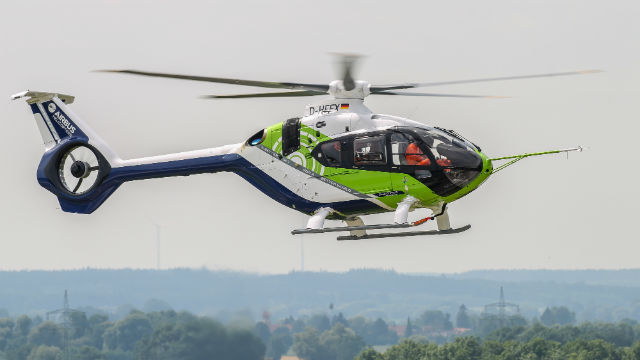Despite successful tests of a number of fuel-saving and noise-reducing features aboard its EC135-derived Bluecopter demonstrator, Airbus Helicopters is unlikely to transfer any of the technologies to the current iteration of its best-selling light twin. Instead, the manufacturer is looking to simplify production as a means of keeping costs down and reacting to customer feedback.
Airbus Helicopters’ problem is that from early 2017, it will be producing three separate variants of the 2.9t rotorcraft. As well as the current H135 P3 or T3 models, which were introduced in late 2014, its output will also consist of aircraft fitted with the new Helionix avionics suite, as well as those built to the older P2/T2 standard.
“It is one of my concerns because it is not providing me the cost benefits with my production because I have to service several variants,” says H135 programme manager Axel Humpert.
Around 10% of the company's 84-unit backlog for the type is for P2/T2-standard helicopters, he says, but it is aiming to cease making the older variant in 2018.
Although some contracts specify delivery in 2019, he says, the company will look to either convert customers to the new variant, or simply store aircraft for later delivery. In addition, Airbus Helicopters will from 2017 institute a price increase on H135s fitted with the pre-Helionix glass cockpit, to encourage migration to the newer standard, “for product policy reasons”.
Airbus Helicopters will not accept orders for the current variant beyond 2017, with production to switch to the Helionix-equipped model the following year.
“I want to finish with the current glass cockpit in 2018 to stabilise my production on one type only,” says Humpert.
The push to simplify production means that none of the technologies validated by the Bluecopter demonstrator over the past two years – which included aerodynamic improvements, an enhanced shrouded tail rotor and distinctive curved main rotor blades – will make their way onto the H135, at least in the short or medium term.

Airbus Helicopters
“The P3/T3 Helionix version is and will remain our product for many years to come,” says Humpert. However, he acknowledges that the Bluecopter will “certainly provide technology for the H135 in the future”.
“Once we are forced to do a step it will be a step where we expect more than a small aerodynamic improvement,” he says.
Mitigating against any further short-term changes is that “customers would like to see a stabilisation of the production line or product line. They would like us to maintain [one] configuration for a number of years," Humpert adds.
P3 helicopters are powered by twin Pratt & Whitney Canada PW206B2B engines, while the T3 uses a pair of Safran Helicopter Engines Arrius 2B2+ powerplants.
Source: FlightGlobal.com


























